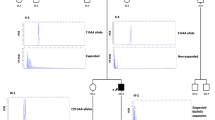Abstract
Friedreich ataxia (FRDA) is the most common hereditary ataxia. It is an autosomal recessive disorder caused by mutations of the FXN gene, mainly the biallelic expansion of the (GAA)n repeats in its first intron. Heterozygous expansion/point mutations or deletions are rare; no patients with two point mutations or a point mutation/deletion have been described, suggesting that loss of the FXN gene product, frataxin, is lethal. This is why routine FRDA molecular diagnostics is focused on (GAA)n expansion analysis. Additional tests are considered only in cases of heterozygous expansion carriers and an atypical clinical picture. Analyses of the parent’s carrier status, together with diagnostic tests, are performed in rare cases, and, because of that, we may underestimate the frequency of deletions. Even though FXN deletions are characterised as ‘exquisitely rare,’ we were able to identify one case (2.4 %) of a (GAA)n expansion/exonic deletion in a group of 41 probands. This was a patient with very early onset of disease with rapid progression of gait instability and hypertrophic cardiomyopathy. We compared the patient’s clinical data to expansion/deletion carriers available in the literature and suggest that, in clinical practice, the FXN deletion test should be taken into account in patients with early-onset, rapid progressive ataxia and severe scoliosis.


Similar content being viewed by others
References
Anheim M, Mariani LL, Calvas P, Cheuret E, Zagnoli F, Odent S, Seguela C, Marelli C, Fritsch M, Delaunoy JP, Brice A, Dürr A, Koenig M (2012) Exonic deletions of FXN and early-onset Friedreich ataxia. Arch Neurol 69:912–916
Bidichandani SI, Delatycki MB (1998) Friedreich ataxia. In: Pagon RA, Adam MP, Ardinger HH, Wallace SE, Amemiya A, Bean LJH, Bird TD, Fong CT, Mefford HC, Smith RJH, Stephens K (eds) GeneReviews® [Internet]. Seattle (WA): University of Washington, Seattle; 1993–2015 [updated 2014 Jul 24]
Campuzano V, Montermini L, Moltò MD, Pianese L, Cossée M, Cavalcanti F, Monros E, Rodius F, Duclos F, Monticelli A, Zara F, Cañizares J, Koutnikova H, Bidichandani SI, Gellera C, Brice A, Trouillas P, De Michele G, Filla A, De Frutos R, Palau F, Patel PI, Di Donato S, Mandel JL, Cocozza S, Koenig M, Pandolfo M (1996) Friedreich’s ataxia: autosomal recessive disease caused by an intronic GAA triplet repeat expansion. Science 271:1423–1427
Campuzano V, Montermini L, Lutz Y, Cova L, Hindelang C, Jiralerspong S, Trottier Y, Kish SJ, Faucheux B, Trouillas P, Authier FJ, Dürr A, Mandel JL, Vescovi A, Pandolfo M, Koenig M (1997) Frataxin is reduced in Friedreich ataxia patients and is associated with mitochondrial membranes. Hum Mol Genet 6:1771–1780
Cossée M, Schmitt M, Campuzano V, Reutenauer L, Moutou C, Mandel JL, Koenig M (1997) Evolution of the Friedreich’s ataxia trinucleotide repeat expansion: founder effect and premutations. Proc Natl Acad Sci U S A 94:7452–7457
Delatycki MB, Williamson R, Forrest SM (2000) Friedreich ataxia: an overview. J Med Genet 37:1–8
Deutsch EC, Santani AB, Perlman SL, Farmer JM, Stolle CA, Marusich MF, Lynch DR (2010) A rapid, noninvasive immunoassay for frataxin: utility in assessment of Friedreich ataxia. Mol Genet Metab 101:238–245
Harding AE (1981) Friedreich’s ataxia: a clinical and genetic study of 90 families with an analysis of early diagnostic criteria and intrafamilial clustering of clinical features. Brain 104:589–620
Hoffman-Zacharska D, Mazurczak T (2008) Zastosowanie metody TP-PCR (Triplet Repeat Primed PCR) w diagnostyce molekularnej ataksji Friedreicha. Diag Lab 44:439–447
Mazurczak T, Hoffman-Zacharska D (2009) Ataksja Friedreicha—algorytm diagnostyki klinicznej i molekularnej. Pediatria Polska 84:13–19
Montermini L, Andermann E, Labuda M, Richter A, Pandolfo M, Cavalcanti F, Pianese L, Iodice L, Farina G, Monticelli A, Turano M, Filla A, De Michele G, Cocozza S (1997) The Friedreich ataxia GAA triplet repeat: permutation and normal alleles. Hum Mol Genet 6(8):1261–1266
Pandolfo M (2008) Friedreich ataxia. Arch Neurol 65:1296–1303
Pandolfo M, Montermini L (1998) Prenatal diagnosis of Friedreich ataxia. Prenat Diagn 18:831–833
Potdar PD, Raghu A (2013) Review on molecular diagnostic techniques in Friedreich’s ataxia. Annu Rev Res Biol 3(4):659–677
Ryan F (2001) Best practice guidelines for molecular analysis of Friedreich ataxia. Best practice guidelines for molecular analysis of Friedreich ataxia (EMQN). Available online at: http://www.emqn.org/emqn/digitalAssets/0/234_FRDA.pdf
Schmitt M, Warner J, Barron L, Mandel J, Koenig M (2000) Detection of large (GAA)n repeat expansions by fluorescent PCR. Poster presented at the European Human Genetics Conference 2000, 32nd annual meeting of the European Society of Human Genetics (ESHG), Amsterdam, The Netherlands, May 2000
Sharma R, Bhatti S, Gomez M, Clark RM, Murray C, Ashizawa T, Bidichandani SI (2002) The GAA triplet-repeat sequence in Friedreich ataxia shows a high level of somatic instability in vivo, with a significant predilection for large contractions. Hum Mol Genet 11:2175–2187
Tsou AY, Paulsen EK, Lagedrost SJ, Perlman SL, Mathews KD, Wilmot GR, Ravina B, Koeppen AH, Lynch DR (2011) Mortality in Friedreich ataxia. J Neurol Sci 307:46–49
van den Ouweland AM, van Minkelen R, Bolman GM, Wouters CH, Becht-Noordermeer C, Deelen WH, Deelen-Manders JM, Ippel EP, Saris J, Halley DJ (2012) Complete FXN deletion in a patient with Friedreich’s ataxia. Genet Test Mol Biomarkers 16:1015–1018
Warner JP, Barron LH, Goudie D, Kelly K, Dow D, Fitzpatrick DR, Brock DJ (1996) A general method for the detection of large CAG repeat expansions by fluorescent PCR. J Med Genet 33:1022–1026
Zühlke CH, Dalski A, Habeck M, Straube K, Hedrich K, Hoeltzenbein M, Konstanzer A, Hellenbroich Y, Schwinger E (2004) Extension of the mutation spectrum in Friedreich’s ataxia: detection of an exon deletion and novel missense mutations. Eur J Hum Genet 12:979–982
Acknowledgements
This work was partially supported by grant 2P05E11529.
Author information
Authors and Affiliations
Corresponding author
Additional information
Communicated by: Michal Witt
Rights and permissions
About this article
Cite this article
Hoffman-Zacharska, D., Mazurczak, T., Zajkowski, T. et al. Friedreich ataxia is not only a GAA repeats expansion disorder: implications for molecular testing and counselling. J Appl Genetics 57, 349–355 (2016). https://doi.org/10.1007/s13353-015-0331-4
Received:
Revised:
Accepted:
Published:
Issue Date:
DOI: https://doi.org/10.1007/s13353-015-0331-4




